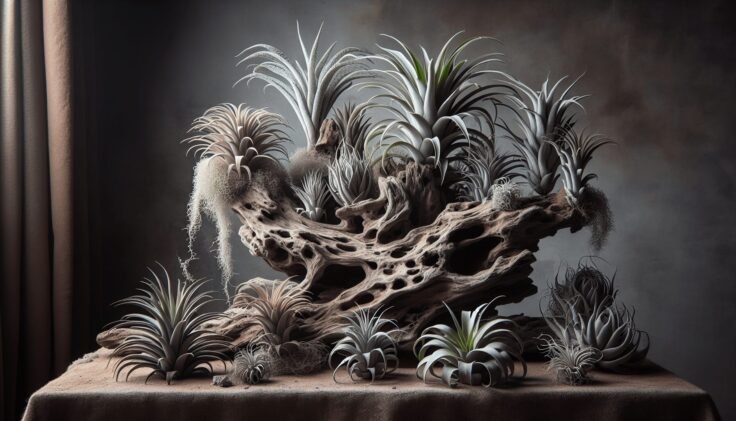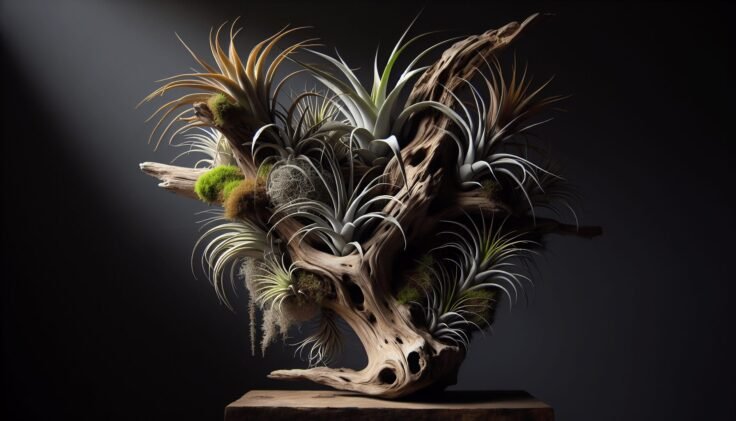Have you ever wondered how to bring a piece of nature indoors while maintaining a unique and artistic touch? Creating a driftwood airplant display might just be the answer for you. This captivating blend of rustic driftwood and ethereal airplants is not only visually stunning but also an excellent way to add a touch of nature to your space without a lot of maintenance. Here, you’ll find a comprehensive guide on creating your own piece of living art using driftwood and airplants. Let’s dig deep into the elements, benefits, and steps necessary to craft and care for these beautiful displays.
Understanding Driftwood and Airplants
What is Driftwood?
Driftwood refers to any wood that has been washed onto shore by the action of waves, tides, or water currents. Over time, the wood gets weathered and worn, creating a smooth and artistic piece that offers a range of creamy to dark brown hues. This organic material provides a natural framework that can serve as an incredible backdrop for various plant displays, particularly airplants.
The Beauty of Airplants
Airplants, scientifically known as Tillandsias, are unique because they don’t require soil to grow. These fascinating plants absorb moisture and nutrients through their leaves from the air around them. With their ability to cling onto a variety of surfaces and their minimal care requirements, airplants make perfect candidates for your driftwood display. They are available in many shapes and sizes, each offering a unique appearance that can add character to your driftwood piece.
The Allure of Driftwood Airplant Displays
Combining driftwood with airplants creates an eye-catching fusion that stands as a testament to the simplicity and beauty of nature. It’s a low-maintenance option for those seeking a green thumb project without the overwhelm of traditional gardening. Not only do these displays make striking décor pieces, but they also improve indoor air quality and create a calming atmosphere with their natural beauty.
Benefits of Driftwood Airplant Displays
- Aesthetic Appeal: The natural lines, textures, and colors of driftwood perfectly highlight the vibrant, unique shapes of airplants.
- Minimal Maintenance: With no soil and minimal water and light requirements, these displays are ideal for individuals with busy schedules.
- Versatility: Suitable for any interior style, from modern minimalism to rustic elegance, these displays adapt to various décor themes.
- Air Purifying: Airplants absorb toxins and circulate fresh air in the environment, contributing to a healthier indoor space.

Getting Started with Your Driftwood Airplant Display
Before you start assembling your display, take some time to gather necessary materials and consider the basic principles of design and plant care. This will ensure your piece is not only beautiful but also long-lasting.
Materials You Will Need
- Driftwood: Seek pieces that feature interesting shapes and sturdy form. Consider size based on where you plan to display it.
- Airplants: Choose a variety or similar-looking Tillandsias to create a cohesive or eclectic look.
- Adhesive: Non-toxic glue or fishing line can help secure plants without harming them.
- Optional Accessories: Pebbles, moss, or shells for added texture.
- Spray Bottle: For easy watering.
Finding the Right Driftwood
Selecting the right piece of driftwood is crucial as it forms the canvas for your display. Larger pieces make a great centerpiece, while smaller, delicate ones work well for more intricate designs. You can collect driftwood during a trip to the beach, or purchase from stores specializing in nautical or natural décor. When selecting, check that the wood is dry and free of any mold or insects.
Selecting Your Airplants
With over 600 species of airplants available, your choices are vast. When selecting, consider what is available in your local area or explore online stores for even more options. Varieties like Tillandsia ionantha, Tillandsia xerographica, and Tillandsia stricta are popular choices for their stunning shapes and color transitions. Mix plants of different sizes and forms to create depth and visual interest.
Designing Your Driftwood Airplant Display
Placement and Arrangement
Before you permanently affix your airplants to the driftwood, play around with their positioning. Consider how the shapes and colors of your plants work with the natural lines of the driftwood. Achieving balance in your design might take some experimentation. Imagine how each plant will look from multiple angles and use the existing contours of the wood to your advantage, such as placing plants in crevices or at interesting junctions.
Securing the Airplants
Once satisfied with your arrangement, it’s time to secure the plants. If using glue, ensure it is non-toxic and safe for plants. Alternatively, wrap the base of the plants with clear fishing line to subtly secure them in place. Whatever method you choose, allow some flexibility for the plant to grow and thrive.
Adding Accessories
To enhance your display, consider incorporating accessories like pebbles, decorative moss, or small shells. These additions can add texture and further emphasize the natural beauty of your display. Be mindful not to overpower the plants themselves—let them remain the focal point.

Caring for Your Driftwood Airplant Display
The beauty of a driftwood airplant display is its simplicity in maintenance. However, proper care ensures that your airplants remain healthy and vibrant.
Light Requirements
Airplants generally prosper in bright, indirect light. Place your display near a window with filtered light or beneath artificial lighting for about 12 hours per day. Avoid direct sunlight as it can scorch the plant leaves. Evaluate the light levels in your chosen location and adjust accordingly, perhaps moving your display to better cater to these needs.
Watering Routine
Airplants typically require watering once or twice a week. Using a spray bottle, lightly mist the plants and ensure that excess water doesn’t accumulate on the driftwood as it can lead to rot. Alternatively, you can soak your plants in a bowl of water for 30 minutes weekly. After watering, always allow your airplants to dry completely before returning them to the display to prevent mold.
Temperature and Humidity
Tillandsias are adaptable and can thrive in a range of temperatures but prefer between 50°F and 90°F (10°C to 32°C). Higher humidity levels, typical of kitchens and bathrooms, are beneficial; otherwise, you might need to increase the frequency of watering in drier conditions.
Troubleshooting Common Issues
Even with minimal maintenance, you might encounter some issues with your display. It’s important to diagnose these early to keep your display looking its best.
Signs of Overwatering
Overwatering is a common mistake. Signs include discolored, soggy leaves or a musty smell. Remove the plant immediately if these symptoms appear, allow it to dry completely, and reduce watering frequency.
Dealing with Underwatering
Conversely, dry leaf tips or browning can indicate a lack of water. Increase the frequency of watering slightly, and ensure the plant is allowed a full soak occasionally for rehydration.
Addressing Sunburn
Airplants will develop light, bleached patches if exposed to too much direct sunlight. If you notice this, move the display to a spot with indirect light.
Fertilizing Your Airplants
Although not necessary, an occasional feed can boost the health of your airplants. Use a bromeliad fertilizer diluted in water once a month. Keep in mind that over-fertilizing can do more harm than good, so less is more when it comes to fertilizing airplants.
Additional Ideas for Creativity and Customization
Consider these creative twists to personalize your driftwood airplant display further:
Hanging Displays
Suspend your display from the ceiling for an artistic and floating appearance. Use clear fishing line for a nearly invisible hanging mechanism, ensuring that your display rotates slightly for even light exposure.
Wall-Mounted Displays
Attach the display to a background panel for wall mounting. Driftwood offers lightweight options that secure easily to walls with hooks or nails, perfect for creating living wall art.
Creative Lighting
Integrate small LED lights to highlight your airplants during the evening. Such lighting can accentuate the beautiful colors and shapes of the plants while establishing a calming atmosphere.
Themed Displays
Create thematic displays using thematic accessories, such as a seaside ambiance with shells and sand, or a botanical theme incorporating ferns and moss. Tailor these ideas to suit specific rooms or occasions.
Conclusion
Crafting a driftwood airplant display is all about blending natural aesthetics with minimal maintenance while expressing your personal style. Whether you’re a seasoned plant enthusiast or a novice looking to dip your toes into the world of indoor greenery, these displays offer a rewarding project with aesthetically pleasing results. By understanding both the art of arrangement and the needs of your airplants, you can create a striking piece of living décor that transforms your space. Remember to keep care tips in mind and enjoy the tranquility and visual allure that these displays bring into your life.